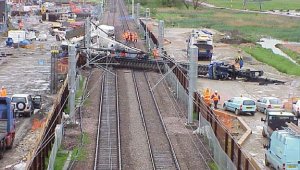 |
||
|
Guidance > Working Platforms > FAQs WORKING PLATFORM FREQUENTLY ASKED QUESTIONS
Why must the working platform be designed for piling rigs?A working platform is the foundation for a piece of machinery that may weigh anything from 5 tonnes to more than 150 tonnes. Although stable when on a firm surface, a 1m2 soft spot can be sufficient to unbalance the rig and cause it to topple over. Every year piling rigs fall over. ‘Near misses’ due to the site surface are even more common. Why have FPS Members introduced the Working Platform Certificate (WPC)?The FPS has developed the WPC in order to raise awareness of the importance of providing a proper platform for the plant which will work on it – and the importance of maintaining it during the course of the contract. Signing the certificate confirms your awareness of these requirements. Why isn’t it sufficient to inspect the working platform prior to work commencing?Attempting to assess the adequacy of a working platform by visual inspection is one of the failings of the historic practice that the WPC is addressing. Is this just a way for the Piling Contractor to transfer his own responsibilities?The WPC does not seek to transfer any responsibilities. Both the Principal Contractor and the Piling Subcontractor already have responsibilities under CDM and the Health and Safety at Work Act. The use of the WPC is a way of highlighting these responsibilities by increasing awareness of platform safety and the importance of maintaining the platform in good condition throughout the contract. The WPC is not legislation, so why should I sign it?The WPC does not impose any additional responsibility, it merely confirms that the Principal Contractor has fulfilled his obligations under CDM, which does have statutory force. In this respect it is not unlike a permit to dig, which is widely used but is also not a statutory requirement. The initiative has the support of the HSE. Who has responsibility under CDM?The principal contractor has a responsibility under CDM regulations to ensure that all activities are carried out by suitably qualified persons, and this includes the platform design, installation and maintenance. The Working Platform Certificate is to be signed by the principal contractor to confirm that the design, construction and maintenance has been / will be carried out by competent persons. It does not state who will carry out these activities. How is design responsibility apportioned?This is a matter for agreement between the main or principal contractor and the specialist contractor whose plant will be working on the site. The introduction of the Working Platform Certificate has not changed the previously existing commercial or contractual situation with regard to who actually has responsibility for the design of the working platform, other than ensuring it is clarified instead of being a grey area as often used to be the case. What is meant by maintenance of the Working Platform?The working platform can deteriorate due to use over time. Additionally, excavations, trenches or other holes dug in the platform surface must be properly backfilled to avoid creating a soft spot that might give way under the tracks of a piling rig or other plant and equipment. The edge of the platform must always be clearly defined and should be regularly inspected to ensure that there has been no degradation over time. Why don’t all Piling Contractors take responsibility for
design and installation of the Working Platform?
|
Documents AvailableUse of 'Structural Geosynthetic Reinforcement' - a BRE review seven years on FPS Guide to Hydraulically Bound Platforms Working platform design sensitivity Calculation of track bearing pressures
|
|
